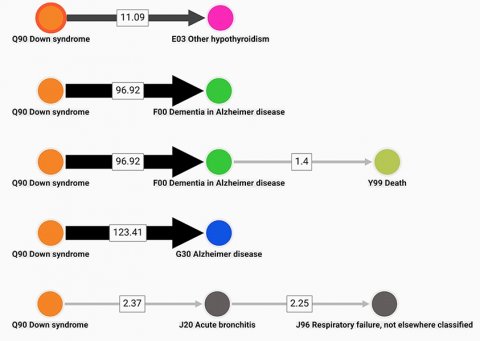Image source: Pexels/Isaque Pereira
News • Trajectory browser
New tool shows main highways of disease development
As people get older they often jump from disease to disease and carry the burden of more chronic diseases at once. But is there a system in the way diseases follow each other?
Danish researchers have for the past six years developed a comprehensive tool, the Danish Disease Trajectory Browser, that utilizes 25 years of public health data from Danish patients to explore what they call the main highways of disease development.
The tool is published in Nature Communications; the Danish Disease Trajectory Browser is freely accessible via this link.

Image source: University of Copenhagen
“A lot of research focus is on investigating one disease at a time. We try to add a time perspective and look at multiple diseases following each other to discover where are the most common trajectories – what are the disease highways that we as people encounter,” says professor Søren Brunak from the Novo Nordisk Foundation Center for Protein Research at University of Copenhagen.
To illustrate the use of the tool the research group looked at data for Down Syndrome patients and showed, as expected, that these patients in general are diagnosed with Alzheimer’s Disease at an earlier age that others. Other frequent diseases are displayed as well.
We compute statistics over many patients and have boiled it down to data points that visualize how often patients with one disease get a specific other disease at a later point
Søren Brunak
In general, there is a barrier for working with health data in research. Both in terms of getting approval from authorities to handle patient data and the fact that researchers need specific technical skills to extract meaningful information from the data. “We wanted to make an easily accessible tool for researchers and health professionals where they don’t necessarily need to know all the details. The statistical summary data on disease to disease jumps in the tool are not person-sensitive. We compute statistics over many patients and have boiled it down to data points that visualize how often patients with one disease get a specific other disease at a later point. So we are focusing on the sequence of diseases,” says Søren Brunak.
The Danish Disease Trajectory Browser is freely available for the scientific community and uses WHO’s disease codes. Even though there are regional differences in disease patterns the tool is highly relevant in an international context to compare i.e. how fast diseases progress in different countries.
For Søren Brunak the tool has a great potential in personalized medicine. “In personalized medicine a part of the job is to divide patients into subgroups that will benefit most from a specific treatment. By knowing the disease trajectories you can create subgroups of patients not just by their current disease, but based on their previous conditions and expected future conditions as well. In that way you find different subgroups of patients that may need different treatment strategies,” Søren Brunak explains.
Currently the Disease Trajectory Browser contains data from 1994 to 2018 and will continuously be updated with new data.
Source: University of Copenhagen
05.10.2020











